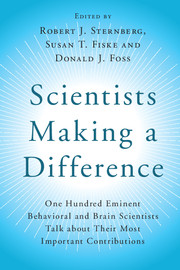 Scientists Making a Difference
Scientists Making a Difference Book contents
- Frontmatter
- Contents
- List of Contributors
- Foreword: Making a Creative Difference = Person × Environment
- Preface
- Part I Introduction
- Part II Biological Bases of Psychology: Genes, Brain, and Beyond
- Part III Cognition: Getting Information from the World and Dealing with It
- Part IV Development: How We Change Over Time
- Part V Motivation and Emotion: How We Feel and What We Do
- Part VI Social and Personality Processes: Who We Are and How We Interact
- Part VII Clinical and Health Psychology: Making Lives Better
- Section A Stress and Coping
- Section B Understanding Mental Disorders
- Section C Psychotherapy and Behavior Change
- Section D Health and Positive Psychology
- 98 Psychological Origins of Cardiovascular Disease
- 99 How Positive Psychology Happened and Where It Is Going
- 100 Looking Back and Forward
- Part VIII Conclusion
- Afterword: Doing Psychology 24×7 and Why It Matters
- Index
99 - How Positive Psychology Happened and Where It Is Going
from Section D - Health and Positive Psychology
Published online by Cambridge University Press: 05 August 2016
- Frontmatter
- Contents
- List of Contributors
- Foreword: Making a Creative Difference = Person × Environment
- Preface
- Part I Introduction
- Part II Biological Bases of Psychology: Genes, Brain, and Beyond
- Part III Cognition: Getting Information from the World and Dealing with It
- Part IV Development: How We Change Over Time
- Part V Motivation and Emotion: How We Feel and What We Do
- Part VI Social and Personality Processes: Who We Are and How We Interact
- Part VII Clinical and Health Psychology: Making Lives Better
- Section A Stress and Coping
- Section B Understanding Mental Disorders
- Section C Psychotherapy and Behavior Change
- Section D Health and Positive Psychology
- 98 Psychological Origins of Cardiovascular Disease
- 99 How Positive Psychology Happened and Where It Is Going
- 100 Looking Back and Forward
- Part VIII Conclusion
- Afterword: Doing Psychology 24×7 and Why It Matters
- Index
Summary
How It Happened
“You're in deep shit, Marty,” confided Ron Levant to me over a double scotch shortly after I had bombed in my attempt to persuade CAPP of my bright idea. CAPP was the organization of independent therapists that had controlled the 160,000-member American Psychological Association (APA) for two decades, and they were none too happy about my surprise election – by the largest margin in memory – to the Presidency of APA. He's a wolf in sheep's clothing, they rightly believed.
APA presidents are supposed to have an initiative and, having worked on the prevention and treatment of depression and helplessness for two decades, I thought mine could be “evidence-based treatment and prevention.” So I went to my friend, Steve Hyman, the director of NIMH. He was thrilled and told me he would chip in $40 million dollars if I could get APA working on evidence-based treatment.
So I told CAPP about my plan and about NIMH's willingness. I felt the room get chillier and chillier. I rattled on. Finally, the chair of CAPP memorably said, “What if the evidence doesn't come out in our favor?”
I had made at least one friend in the ruling circles of APA – Ray Fowler, the long-serving and long-suffering CEO – and I limped my way to his office for some fatherly advice.
“Marty,” he opined, “you are trying to be a transactional president. But you cannot out-transact these people. They are the masters of process and have more sitting power in their little fingers than your bottom could ever accumulate. You have to be a transformational leader.”
And so I proposed that Psychology turn its scientific and practice attention away from pathology and victimology and more toward what makes life worth living: positive emotion, positive character, and positive institutions. I never looked back and this became my mission for the next fifteen years. The endeavor was generously backed by the Templeton Foundation and by Atlantic Philanthropies, and, to my surprise, it caught on.
Some metrics of its catching on and making a difference from 1998–2015:
• Funding. From zero to a total of at least $200 million.
• Courses: From none to hundreds and in almost every university in the world.
- Type
- Chapter
- Information
- Scientists Making a DifferenceOne Hundred Eminent Behavioral and Brain Scientists Talk about Their Most Important Contributions, pp. 478 - 480Publisher: Cambridge University PressPrint publication year: 2016
